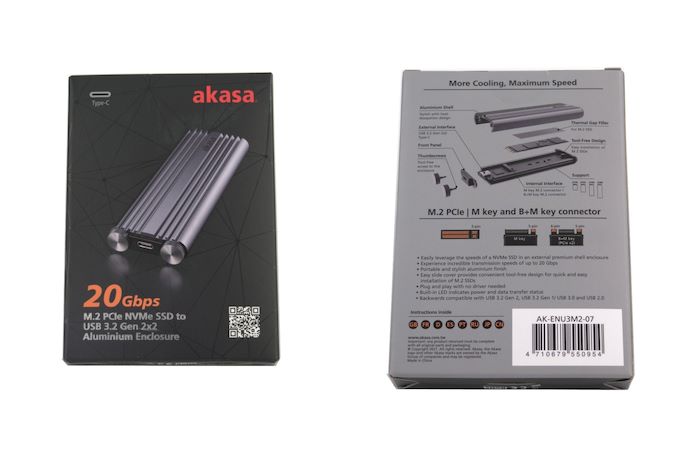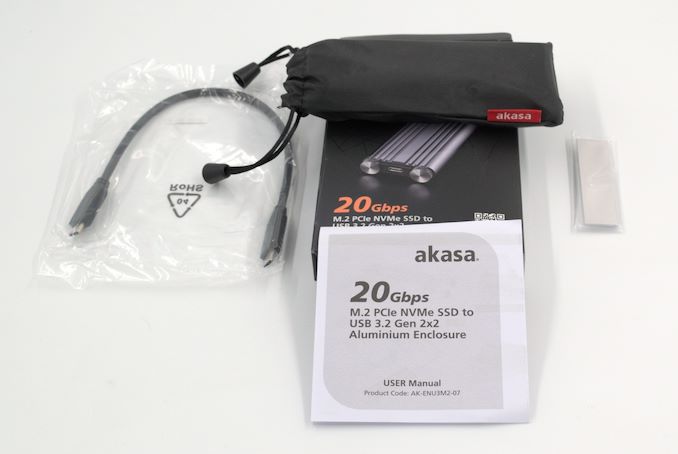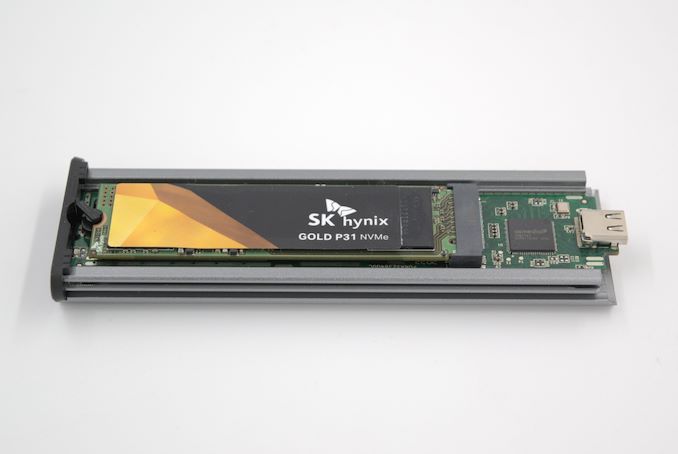Akasa AK-ENU3M2-07 USB 3.2 Gen 2x2 SSD Enclosure Review: 20Gbps with Excellent Thermals
by Ganesh T S on August 1, 2022 8:00 AM EST
Storage bridges have become an ubiquitous part of today's computing ecosystems. The bridges may be external or internal, with the former ones enabling a range of direct-attached storage (DAS) units. These may range from thumb drives using an UFD controller to full-blown RAID towers carrying Infiniband and Thunderbolt links. From a bus-powered DAS viewpoint, Thunderbolt has been restricted to premium devices, but the variants of USB 3.2 have emerged as mass-market high-performance alternatives. USB 3.2 Gen 2x2 enables the highest performance class (up to 20 Gbps) in USB devices without resorting to PCIe tunneling.
The last couple of years have seen many vendors introduce new products in this 20 Gbps-performance class - including portable SSDs and M.2 NVMe SSD enclosures. Host support has also started to look up. The key challenges for enclosures and portable SSDs supporting USB 3.2 Gen 2x2 include handling power consumption and managing thermals. We have been analyzing these aspects (in addition to regular performance numbers) in our reviews of the 20Gbps-performance class PSSDs and enclosures. The review below presents our evaluation report of Akasa's AK-ENU3M2-07 - a USB 3.2 Gen 2x2 enclosure for M.2 NVMe SSDs.
Introduction and Product Impressions
SSD speeds and storage capacity have improved significantly in the last decade, thanks to rapid advancements in flash technology as well as high-speed interfaces / protocols. Starting from 2.5-inch disk drives barely able to saturate the SATA III (6 Gbps) interface in the early 2010s, we now have gumstick- and palm-sized drives with PCIe 4.0 support capable of sustaining more than 7000 MBps (56 Gbps).
These SSDs have also formed the base platform for portable SSDs. Traditionally, such drives have fallen into one of the six categories below, depending on the performance profile and internal components. Recently, we have seen direct flash-to-USB controllers across all but the highest performance tier listed here.
- 2.5GBps+ class: Thunderbolt SSDs with PCIe 3.0 x4 NVMe drives
- 2GBps+ class: USB 3.2 Gen 2x2 SSDs with PCIe 3.0 x4 NVMe drives
- 1GBps+ class: USB 3.2 Gen 2 SSDs with PCIe 3.0 (x4 or x2) NVMe drives
- 500MBps+ class: USB 3.2 Gen 2 SSDs with SATA drives
- 400MBps+ class: USB 3.2 Gen 1 SSDs with SATA drives
- Sub-400MBps+ class: USB 3.2 Gen 1 flash drives with direct flash-to-USB controllers
In addition to portable SSDs, this type of segmentation is also applicable to storage enclosures. Since the mid-2010s, we have seen a regular stream of SSD enclosures hit the market, catering to 2.5", mSATA, and M.2 form-factors.
Akasa is a well-known manufacturer of thermal solutions for computing systems targeting industrial applications as well as home consumers. They have been maintaining a lineup of storage bridge products catering to different market segments since 2013. We reviewed a bunch of their M.2 SATA and NVMe enclosures last year, and came away impressed with their comprehensive lineup addressing different requirements. This review looks at the AK-ENU3M2-07, an aluminum enclosure sporting a USB 3.2 Gen 2x2 20Gbps Type-C upstream interface and a M.2 2230/42/60/80 NVMe downstream port internally.
There are currently two shipping device solutions for USB 3.2 Gen 2x2 - the Silicon Motion SM2320 used in portable SSDs like the Kingston XS2000 is a native UFD controller, while the ASMedia ASM2364 is a bridge solution more suitable for use in enclosures. The AK-ENU3M2-07 uses the latter. The enclosure itself is made of solid aluminum with ridges to aid in heat dissipation. It comes with a single Type-C to Type-C cable rated for 20Gbps operation. A single thermal gap filler is supplied in the package along with a carrying pouch and a user manual.
One of the attractive aspects of the AK-ENU3M2-07 is its tool-free nature. Accessing the internal board for SSD installation is a simple matter of loosening up the two screws on either side of the Type-C port. They are big enough to unscrew without the use of any tools. This allows the bottom panel to be slid out. The board itself is affixed to this panel, and doesn't need to be taken out for any purpose. A plastic tab to hold the M.2 SSD in place is affixed to the 2280 hole by default. Rotating this tab along the notch allows the SSD to be placed in and locked in place. Without the SSD in the picture, further rotation to make the longer arm of the tab parallel to the rear panel allows it to be completely taken out (and affixed to one of the other holes corresponding to 30mm, 40mm, or 60mm SSD lengths). After the installation of the SSD, the thermal gap filler can be placed on top. The gallery below provides pictures of the enclosure as well as the SSD installation steps.
We evaluate M.2 NVMe storage enclosures using the SK hynix Gold P31 1TB NVMe SSD. Since this SSD is used in all the relevant reviews, it makes for an apples-to-apples comparison across different products.
The table below presents a comparative view of the specifications of the different storage bridges and PSSDs presented in this review.
| Comparative Storage Bridges Configuration | ||
| Aspect | ||
| Downstream Port | 1x PCIe 3.0 x4 (M.2 NVMe) | 1x PCIe 3.0 x4 (M.2 NVMe) |
| Upstream Port | USB 3.2 Gen 2x2 Type-C | USB 3.2 Gen 2x2 Type-C |
| Bridge Chip | ASMedia ASM2364 | ASMedia ASM2364 |
| Power | Bus Powered | Bus Powered |
| Use Case | Tool-free M.2 2230 / 2242 / 2260 / 2280 NVMe SSD enclosure DIY 2GBps-class, compact, and sturdy portable SSD with a gumstick form-factor |
M.2 2230 / 2242 / 2260 / 2280 NVMe SSD enclosure DIY 2GBps-class, compact, and sturdy portable SSD with a USB flash drive-like form-factor |
| Physical Dimensions | 122 mm x 46 mm x 15 mm | 105 mm x 40 mm x 12 mm |
| Weight | 112 grams (without cable / SSD / thermal pad) | 60 grams (without cable / SSD ; with thermal pads) |
| Cable | 29 cm USB 3.2 Gen 2x2 Type-C to Type-C | 16 cm USB 3.2 Gen 2x2 Type-C to Type-C 16 cmd USB 3.2 Gen 2 Type-C to Type-A |
| S.M.A.R.T Passthrough | Yes | Yes |
| UASP Support | Yes | Yes |
| TRIM Passthrough | Yes | Yes |
| Hardware Encryption | SSD-dependent | SSD-dependent |
| Evaluated Storage | SK hynix P31 PCIe 3.0 x4 NVMe SSD SK hynix 128L 3D TLC |
SK hynix P31 PCIe 3.0 x4 NVMe SSD SK hynix 128L 3D TLC |
| Price | GBP 69 | USD 139 |
| Review Link | Akasa AK-ENU3M2-07 Review | Yottamaster HC2-C3 Review |
The key aspect that stands out is how heavy the AK-ENU3M2-07 is, compared to other enclosures using the same bridge chip. While the Akasa enclosure is 112g, the Silverstone MS12 is just 53g, and the Yottamaster HC2 is 60g. This gives the enclosure a higher thermal mass to cool down the SSD inside, and should potentially result in better thermal performance. Prior to looking at the benchmark numbers, power consumption, and thermal solution effectiveness, a description of the testbed setup and evaluation methodology is provided.
Testbed Setup and Evaluation Methodology
Direct-attached storage devices are evaluated using the Quartz Canyon NUC (essentially, the Xeon / ECC version of the Ghost Canyon NUC) configured with 2x 16GB DDR4-2667 ECC SODIMMs and a PCIe 3.0 x4 NVMe SSD - the IM2P33E8 1TB from ADATA.
The most attractive aspect of the Quartz Canyon NUC is the presence of two PCIe slots (electrically, x16 and x4) for add-in cards. In the absence of a discrete GPU - for which there is no need in a DAS testbed - both slots are available. In fact, we also added a spare SanDisk Extreme PRO M.2 NVMe SSD to the CPU direct-attached M.2 22110 slot in the baseboard in order to avoid DMI bottlenecks when evaluating Thunderbolt 3 devices. This still allows for two add-in cards operating at x8 (x16 electrical) and x4 (x4 electrical). Since the Quartz Canyon NUC doesn't have a native USB 3.2 Gen 2x2 port, Silverstone's SST-ECU06 add-in card was installed in the x4 slot. All non-Thunderbolt devices are tested using the Type-C port enabled by the SST-ECU06.
The specifications of the testbed are summarized in the table below:
| The 2021 AnandTech DAS Testbed Configuration | |
| System | Intel Quartz Canyon NUC9vXQNX |
| CPU | Intel Xeon E-2286M |
| Memory | ADATA Industrial AD4B3200716G22 32 GB (2x 16GB) DDR4-3200 ECC @ 22-22-22-52 |
| OS Drive | ADATA Industrial IM2P33E8 NVMe 1TB |
| Secondary Drive | SanDisk Extreme PRO M.2 NVMe 3D SSD 1TB |
| Add-on Card | SilverStone Tek SST-ECU06 USB 3.2 Gen 2x2 Type-C Host |
| OS | Windows 10 Enterprise x64 (21H1) |
| Thanks to ADATA, Intel, and SilverStone Tek for the build components | |
The testbed hardware is only one segment of the evaluation. Over the last few years, the typical direct-attached storage workloads for memory cards have also evolved. High bit-rate 4K videos at 60fps have become quite common, and 8K videos are starting to make an appearance. Game install sizes have also grown steadily even in portable game consoles, thanks to high resolution textures and artwork. Keeping these in mind, our evaluation scheme for direct-attached storage devices involves multiple workloads which are described in detail in the corresponding sections.
- Synthetic workloads using CrystalDiskMark and ATTO
- Real-world access traces using PCMark 10's storage benchmark
- Custom robocopy workloads reflective of typical DAS usage
- Sequential write stress test
In the next section, we have an overview of the performance of the Akasa AK-ENU3M2-07 enclosure in these benchmarks. Prior to providing concluding remarks, we have some observations on the device's power consumption numbers and thermal solution also.




















15 Comments
View All Comments
sparkuss - Monday, August 1, 2022 - link
Any reason none of the Sabrent enclosures made the review?I would have enjoyed having them included before I make my next purchase for doing Macrium Backups for my relatives computers.
sparkuss - Monday, August 1, 2022 - link
Never mind, I see the that all are ASM bridge chips as wellDV8_MKD - Monday, August 1, 2022 - link
Second this5of9Borg - Monday, August 1, 2022 - link
Vantec have been selling this product for months, since early last year according to Amazon.https://www.amazon.com/NVMe-Gen2x2-Type-Enclosure-...
Golgatha777 - Monday, August 1, 2022 - link
A critical flaw with a lot of these enclosures is they use something non-metal to secure the drive into place. If you use it enough times, the securing mechanism will fail much sooner than a metal one. Although this one is a bit slower, I'd recommend it anyway because it won't become e-waste anytime soon with a brass nut and screw being used to secure the drive down into place.https://www.amazon.com/dp/B0892BK5L6
5of9Borg - Monday, August 1, 2022 - link
This is a 10Gbps, not a 20Gbps.AdrianBc - Tuesday, August 2, 2022 - link
No there are two 10 Gbps links in a USB 3 Gen 2x2, for a total of 20 Gbps.Enclosures with 10 Gbps have existed for many years from a lot of vendors, those with 20 Gbps are still rare.
However, also the computer connector must support 20 Gbps, otherwise the speed will fall back to the lowest supported speed, e.g. 10 Gbps or "5 Gbps" (the USB speed named "5 Gbps" is in reality 4 Gbps, so less than half of the speed of a 10 Gbps link).
The advantage of this enclosure over those with Thunderbolt is that the SSD can also be used with old computers, even if at a lower speed. Most Thunderbolt enclosures cannot work when plugged in USB connectors.
meacupla - Monday, August 1, 2022 - link
The these screw in type enclosures have a similar flaw. The self tapping steel screws are screwed into smooth aluminum grooves of the enclosure, but this is not designed to be reused, and the screws end up stripping the aluminum in the end.James5mith - Monday, August 1, 2022 - link
I read this, and all I can think is: "Where are the USB4 enclosures?"5of9Borg - Monday, August 1, 2022 - link
It is coming slowly. You need the bridge chipset ready for USB4, and enclosure manufacturer ready to jump in. Current bridge chipset are few, you can count with 3 fingers, and they are expensive. Enclosures manufacturer is not ready to jump in yet.